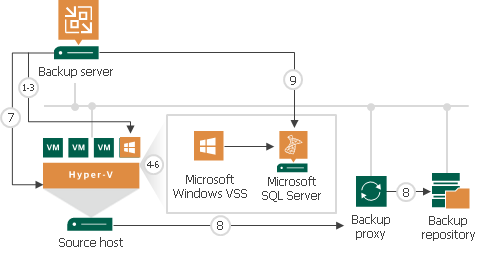应用感知处理
To create transactionally consistent backups or replicas of VMs that run Microsoft Active Directory, Microsoft SQL Server, Microsoft SharePoint, Microsoft Exchange or Oracle, you must enable application-aware processing in job settings.
Application-aware processing is the Veeam technology based on Microsoft VSS. Microsoft VSS is responsible for quiescing applications on the VM and creating a consistent view of application data on the VM guest OS. Use of Microsoft VSS ensures that there are no unfinished database transactions or incomplete application files when Veeam Backup & Replication triggers the VM checkpoint and starts copying VM data to the target. For more information about Microsoft VSS, see Microsoft Docs.
Application-aware processing for Microsoft Windows Server versions is supported by corresponding versions of Microsoft Hyper-V (see Microsoft Docs). To use application-aware processing, you must have Hyper-V Integration Services and the latest updates installed on the VM guest OS.
Important |
If a VM runs an application that does not support Microsoft VSS (there is no VSS writer for this particular type of application, for example, MySQL), Veeam Backup & Replication will not be able to utilize Microsoft VSS and application-aware processing for this VM. To process such VMs, you can use Microsoft Hyper-V guest quiescence with pre-freeze and post-thaw scripts. For more information, see Microsoft Hyper-V Guest Quiescence and Pre-Freeze and Post-Thaw Scripts. |
How Application-Aware Processing Works
If you enable application-aware processing in job settings, Veeam Backup & Replication performs the following operations as a part of the backup or replication process:
- Veeam Backup & Replication deploys the non-persistent runtime components or, if necessary, persistent agent components on the VM and detects if the VM runs any of the supported applications.
- Veeam Backup & Replication collects information about applications installed on VMs — this information is required for VSS-aware restore.
VSS-aware restore is performed when the VM is started after you restore it from the backup or fail over to a VM replica.
- Veeam Backup & Replication prepares applications for VSS-aware restore.
- Microsoft VSS communicates with applications and quiesces I/O activities at a specific point in time.
- Microsoft Hyper-V VSS requestor triggers a VM VSS snapshot.
- Microsoft VSS resumes quiesced I/O activities on the VM guest OS.
- Veeam Backup & Replication triggers a snapshot for the volume on which the VM is located.
- The job session proceeds as usual.
- If you have instructed Veeam Backup & Replication to truncate transaction logs, Veeam Backup & Replication truncates transaction logs on the VM guest OS after the backup or replica are successfully created.

Related Topics